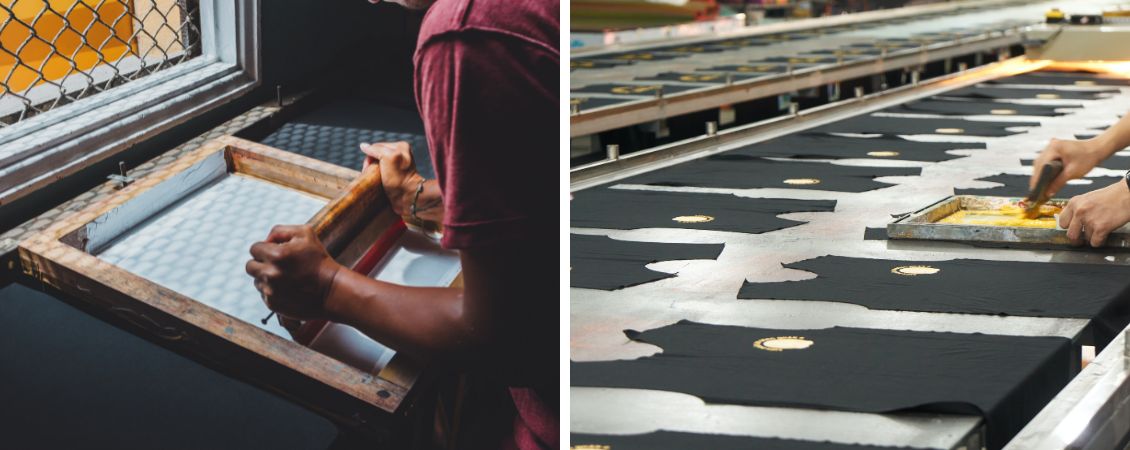Here at instantprint, we use a range of printing techniques to achieve the best results on your products. Across our merchandise range, you can find the likes of screen printing, sublimation printing and direct-to-garment (DTG) printing. But what’s the difference?
Let’s take a closer look at the differences between these printing methods, why we utilise them across different products and what the advantages of each one are in more detail below!
What is Screen Printing?
Screen printing is one of the oldest and most versatile printing techniques, renowned for its durability and vibrant colour reproduction. The process involves transferring ink through a mesh screen onto the desired surface, such as fabric or paper.
When it comes to our tote bags and tea towels, we rely on the tried-and-true method of screen printing. Whether you require a simple logo or a complex design, our screen printing process guarantees exceptional quality and longevity for your tote bags and tea towels. These items are perfect for retail merchandise or promotional items that leave a lasting impression. You can read even more about screen printing in detail in our blog!
Advantages of screen printing
• Long-lasting and durable: Screen printing offers excellent durability, with prints that can withstand frequent washing and extended use.
• Vibrant colours: This method allows for bold and vibrant colour reproduction, making it perfect for designs that require high colour saturation.
• Versatility: Screen printing can be used on various surfaces, including fabrics, paper, and plastic.

What is Sublimation Printing?
Sublimation printing is a technique that uses heat to transfer dye onto a material, typically ceramic or other synthetic fabrics. The process involves printing the design onto a special sublimation paper using sublimation inks and then applying heat and pressure to transfer the design onto the product, resulting in a permanent, vibrant, and durable print.
Our expertise also extends to sublimation printing, which allows us to create stunning and long-lasting designs on our mugs. By utilising sublimation, we can achieve vibrant, full-colour prints that seamlessly blend with the ceramic surface, making our mugs ideal for promotional giveaways or corporate gifts.
Advantages of sublimation printing
• Full-colour, photorealistic prints: Sublimation printing allows for intricate designs, complex colour gradients, and photorealistic images with exceptional clarity.
• Unlimited colour options: Since sublimation dyes become a part of the fabric's fibres, there are no colour limitations, enabling vibrant and eye-catching prints.
• Durability: Sublimation prints are long-lasting, resistant to fading, and can withstand repeated washing without losing their vibrancy.
What is Direct-to-Garment (DTG) Printing?
DTG printing is a relatively newer technology that allows for high-resolution, full-colour prints directly onto garments. It utilises inkjet technology to apply water-based inks onto the fabric, resulting in soft, detailed prints that can capture intricate designs with a wide range of colours.
For our custom t-shirts, we harness the power of direct-to-garment (DTG) printing. This cutting-edge technology enables us to bring your designs to life with intricate detail and accurate colour representation. Our advanced DTG printers apply water-based inks directly onto the fabric, creating soft and comfortable prints that maintain their vibrancy even after multiple washes.
Advantages of direct-to-garment printing
• High level of detail: DTG printing can reproduce intricate designs with fine details, gradients, and shading, making it ideal for complex artwork.
• No colour limitations: DTG printing can achieve a virtually unlimited colour range, including gradients and photorealistic images.
• Quick turnaround time: DTG printing requires minimal set-up time, making it suitable for small runs, one-offs, or even on-demand printing.
What is the difference between DTG printing and screen printing?
DTG printing and screen printing are two distinct methods of custom apparel printing. DTG printing utilises an inkjet printer to directly apply water-based inks onto the fabric, allowing for high-resolution prints with intricate designs and a wide range of colours. Screen printing, on the other hand, involves creating separate stencils for each colour and forcing ink through the screens onto the fabric, resulting in vibrant and durable prints suitable for simpler designs with bold colours.
Which is better sublimation or screen printing?
We offer a range of printing methods to best suit customer needs and the type of product being printed on. Sublimation printing works best on synthetic materials, such as the coating on our ceramic mugs, here, the ink can bond effectively, resulting in durable and long-lasting prints. Whereas products such as tote bags require screen printing to allow for bolder and more solid colours, making screen printing better suited for simpler designs on fabric surfaces.
How do people make merch?
When it comes to printing your logo or design on promotional merchandise, the simplest and most convenient solution is to place your order online. By opting for online ordering, you can save yourself time, effort, and the hassle of dealing with the printing process. Additionally, ordering in bulk online often offers cost-effective pricing, making it an ideal choice for promotional campaigns. Take a look at our wide range of promotional merchandise and kickstart your screen printing project with ease.



.png)

